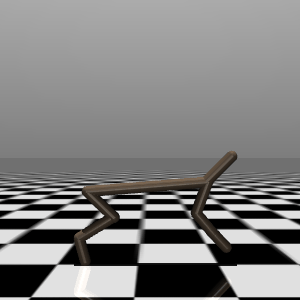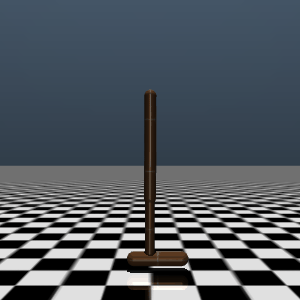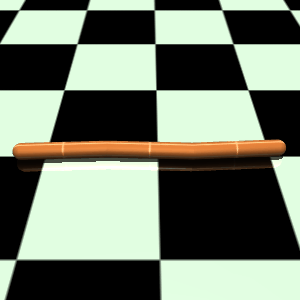🌟 TensorRVEA: Tensorized RVEA for GPU-accelerated Evolutionary Multi-objective Optimization 🌟
Tensorized Reference Vector Guided Evolutionary Algorithm (TensorRVEA) aims to enhance the scalability and efficiency of evolutionary multi-objective optimization by incorporating GPU acceleration. By adapting key data structures and operators into tensor forms, TensorRVEA seeks to utilize GPU-based parallel computing to offer a more efficient approach to complex optimization challenges. The implementation of TensorRVEA is compatible with the EvoX framewrok in JAX.
Below are demonstrations of TensorRVEA applied to various simulated multiobjective robotics environments. Specifically, TensorRVEA optimizes the parameters of the MLP, and then uses this MLP as a policy model to visualize the robot's behavior in the simulated environment.

|

|

|
| MoHalfcheetah | MoHopper-m2 | MoSwimmer |
- MoHalfcheetah: Optimizing for speed and control cost.
- MoHopper-m2: Aiming for maximum speed and jumping height.
- MoSwimmer: Enhancing movement efficiency in fluid environments.
- GPU Acceleration 💻: Leverages GPUs for enhanced computational capabilities.
- Large-Scale Optimization 📈: Ideal for large population sizes and high-dimensional challenges.
- Flexibility 🔨: Compatible with a variety of tensor-based reproduction operators, including GA, DE, PSO, and CSO.
- Real-World Applications 🌐: Suited for complex tasks like multiobjective robotic control (MoBrax), with a special emphasis on neuroevolution methodologies.
TensorRVEA requires:
- evox (version == 0.8.1)
- jax (version >= 0.4.16)
- jaxlib (version >= 0.3.0)
- brax (version == 0.10.3)
- flax
- Visualization tools: plotly, pandas
Sample example for DTLZ problems:
from evox import workflows, problems
import algorithms
from evox.monitors import PopMonitor
from evox.metrics import IGD
import jax
import jax.numpy as jnp
import numpy as np
import time
def run_moea(algorithm, key):
monitor = PopMonitor()
problem = problems.numerical.DTLZ2(m=3)
workflow = workflows.StdWorkflow(
algorithm=algorithm,
problem=problem,
monitor=monitor,
)
state = workflow.init(key)
true_pf = problem.pf()
igd = IGD(true_pf)
for i in range(100):
key, subkey = jax.random.split(key)
state = workflow.step(state)
fit = state.get_child_state("algorithm").fitness
non_nan_rows = fit[~np.isnan(fit).any(axis=1)]
print(f'Generation {i+1}, IGD: {igd(non_nan_rows)}')
fig = monitor.plot()
fig.show()
if __name__ == '__main__':
lb = jnp.full(shape=(12,), fill_value=0)
ub = jnp.full(shape=(12,), fill_value=1)
algorithm = algorithms.TensorRVEA(
lb=lb,
ub=ub,
n_objs=3,
pop_size=100,
)
key = jax.random.PRNGKey(42)
start = time.time()
run_moea(algorithm, key)
end = time.time()
print(f"time: {end-start}s")Sample example for MoBrax:
from algorithms import TensorRVEA
from evox.workflows import StdWorkflow
from evox.monitors import StdMOMonitor
from evox.utils import TreeAndVector
import jax
import jax.numpy as jnp
from flax import linen as nn
import time
import problems
from evox.operators.sampling import UniformSampling
from evox.metrics import HV
from metrics.expected_utility import ExpectedUtility
env_name = "mo_swimmer"
class Model(nn.Module):
@nn.compact
def __call__(self, x):
x = nn.Dense(16)(x)
x = nn.tanh(x)
x = nn.Dense(2)(x)
x = nn.tanh(x)
return x
def main():
key = jax.random.PRNGKey(43)
model_key, workflow_key = jax.random.split(key)
model = Model()
params = model.init(model_key, jnp.zeros((8,)))
adapter = TreeAndVector(params)
monitor = StdMOMonitor(record_pf=False)
problem = problems.MoBrax(
policy=jax.jit(model.apply),
env_name=env_name,
cap_episode=1000,
num_obj=2,
)
center = adapter.to_vector(params)
workflow = StdWorkflow(
algorithm=TensorRVEA(
lb=jnp.full_like(center, -8),
ub=jnp.full_like(center, 8),
n_objs=2,
pop_size=100,
uniform_init=False,
),
problem=problem,
monitor=monitor,
num_objectives=2,
pop_transform=adapter.batched_to_tree,
opt_direction="max",
)
state = workflow.init(workflow_key)
step_func = jax.jit(workflow.step).lower(state).compile()
state = step_func(state)
w = UniformSampling(100, 2)()[0]
ref = jnp.array([0, -1])
hv_metric = HV(ref=-ref)
eu_metric = ExpectedUtility(w=w)
start = time.time()
for i in range(100):
key, subkey = jax.random.split(key)
state = step_func(state)
f = -state.get_child_state("algorithm").fitness
f = f[~jnp.isnan(f).any(axis=1)]
current_f = f[jnp.all(f >= ref, axis=1)]
if current_f.shape[0] == 0:
hv = 0
eu = 0
else:
hv = hv_metric(jax.random.split(workflow_key)[1], -current_f)
eu = eu_metric(current_f)
print(f'Generation {i+1}, HV: {hv}, EU: {eu}')
end = time.time()
print(f"Total time: {end - start}s")
if __name__ == "__main__":
main()- Engage in discussions and share your experiences on GitHub Discussion Board.
- Join our QQ group (ID: 297969717).
If you use TensorRVEA in your research and want to cite it in your work, please use:
@inproceedings{tensorrvea,
author = {Liang, Zhenyu and Jiang, Tao and Sun, Kebin and Cheng, Ran},
title = {GPU-accelerated Evolutionary Multiobjective Optimization Using Tensorized RVEA},
year = {2024},
doi = {10.1145/3638529.3654223},
booktitle = {Proceedings of the Genetic and Evolutionary Computation Conference},
pages = {566–575},
numpages = {10},
location = {Melbourne, VIC, Australia},
series = {GECCO '24}
}

